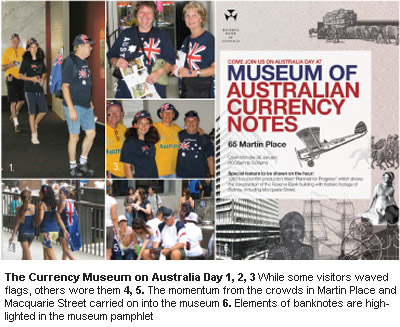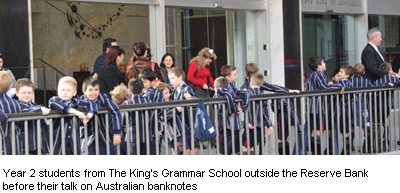Reserve Bank of Australia Annual Report – 2009 The Reserve Bank in the Community
Activities of the State Offices
In addition to its Head Office located in Sydney, the Reserve Bank has offices in Melbourne, Brisbane, Adelaide and Perth.[1] These State Offices play an important role in the Bank's business liaison program and form a key component of the Bank's communication with members of the public, business, government and academia in their respective States.
Since 2001, the Reserve Bank has devoted significant resources to systematically building relationships across a broad cross-section of the business community, with a view to gaining first-hand insights into conditions in different industries and regions within the national economy. The staff involved in the business liaison program have built up a pool of over 1,500 regular contacts around the country, with staff in the State Offices playing a critical part. The information obtained is reported in detail to Head Office and incorporated into the material prepared for monthly Board meetings and in the quarterly Statement on Monetary Policy. In this way, information obtained from liaison is used as a complement to standard sources, such as data from the Australian Bureau of Statistics and business surveys, in forming the Bank's assessments of the economy. This information has proved particularly informative over the past year.
Staff in the State Offices also play a role in the Bank's efforts to keep the public informed of its evolving views on the economy. They interact with a broad cross-section of the community, regularly giving presentations on economic developments to business groups, community organisations and educational institutions, in both State capitals and regional centres. They also facilitate visits by senior staff from Head Office's Economic Group each quarter to brief groups of liaison contacts about the main themes following the release of the Statement on Monetary Policy.
Liaison with Small Businesses
The Reserve Bank continues to convene its Small Business Advisory Panel, which meets annually to discuss issues relating to the provision of finance and the broader economic environment for small businesses. Membership of the Panel is drawn from a wide range of industries across the country. The Panel represents a valuable source of information on the financial and economic conditions faced by small businesses.
Museum of Australian Currency Notes
The Reserve Bank's museum exhibits the story of Australia's currency notes against the background of the nation's broader history. It commences with the types of money used before Federation, ranging from a rum bottle used in early colonial days to Australia's first gold coins. Visitors can then view the various notes produced since the first Australian note series in 1913–1915. The final stage of the museum focuses on Australia's polymer currency notes, including information on their design, security features and potential for recycling. When viewing the original notes, visitors can observe the evolution of Australian identity as expressed through currency notes, learn about the men and women represented on the notes and the artwork used in their design. The notes are presented alongside displays of key episodes in Australian history captured in archival film, photographs and documents.
Over 11,000 people visited the museum in 2008/09, including more than 1,000 visitors on Australia Day 2009. The museum remains popular with school groups. Many of these groups receive a short presentation on the role of the Reserve Bank or, in the case of senior economics students, a talk on the Australian economy. This year, for the first time, presentations were extended to primary school students, who received a talk on the role of money and the special features of Australian banknotes. Most of the information in the museum is on the Bank's website, where visitors can also take a virtual tour of the museum. Around 250,000 people visited the museum online in the past year, with around half of these being from other countries.


Assistance for Research and Education
The Reserve Bank sponsors Australian and international economic research in areas that are closely aligned with its primary responsibilities. This sponsorship includes financial support for conferences, workshops, data gathering, journals and special research projects, and encompasses areas of study such as macroeconomics, econometrics and finance.
In 2008/09 the Reserve Bank continued its longstanding contribution towards the cost of a monthly survey of inflation expectations undertaken by the Melbourne Institute of Applied Economic and Social Research at the University of Melbourne, and a quarterly survey of union inflation and wage expectations undertaken by the Workplace Research Centre at the University of Sydney.
The Reserve Bank continued to provide financial support for the International Journal of Central Banking, the primary objectives of which are to disseminate first-class policy-relevant and applied research on central banking and to promote communication among researchers inside and outside central banks. The Bank continued its support of the International Accounting Standards Committee Foundation, with the second of three pledges following completion in 2005 of the initial five-year support plan. It also maintained its longstanding practice of contributing to the Group of Thirty's program of research and publications in the area of international finance.
Financial assistance to Australian universities each year includes contributions towards the costs of their organising conferences in economics and closely related fields. In 2008/09, these conferences included the 21st Conference for PhD Students in Economics and Business, held at the Australian National University; the Economic Society of Australia's 37th Conference of Economists, held on the Gold Coast; a Conference on Behavioural Macroeconomics, held at the Reserve Bank's Coombs Centre, organised by the Centre for Applied Macroeconomic Analysis at the Australian National University; the 14th Melbourne Money and Finance Conference; the 14th Australasian Macroeconomic Workshop, held at Deakin University; the Australasian Meeting of the Econometric Society, held in Wellington, New Zealand; the University of New South Wales 21st Australasian Finance and Banking Conference; the Financial Integrity Research Network PhD Tutorial, held at the University of Technology, Sydney; and the 4th Annual Workshop in Macroeconomic Dynamics, held at the National University of Singapore. The Bank is also assisting a research project on real-time forecasting, convened by Professor Shaun Vahey of the University of Melbourne.
The Reserve Bank sponsors an annual essay competition for undergraduate students across Australia, organised jointly with the University of New South Wales Economics Society, in order to engage and support students of economics. In 2008 the theme of the competition was ‘Housing Costs and Affordability in Australia’. Amy Wagner (University of Queensland) wrote the winning essay, the runner up was Louise Burns (Curtin University), and the best essay from a first-year student was written by Rhea Thrift (University of Newcastle). These students were presented with their prizes by the Governor at a ceremony in October. For the 2009 competition, students have been invited to submit an essay on the theme of ‘Policy Responses to the Global Financial Crisis’.
In conjunction with APRA, the Reserve Bank has continued sponsorship of the Brian Gray Scholarship Program, initiated in 2002 in memory of a former senior officer of the Bank and APRA. Four scholarships were awarded under this program in 2009, one for PhD study on whether trust law provides an appropriate foundation for governing superannuation, at the University of New South Wales, and three for honours year studies: at the University of Queensland, modelling the behaviour of interbank markets under asymmetric information; at Macquarie University, on a multi-model inference for determining insurance reserve levels; and at the University of New South Wales, on the analysis of pricing and risk management aspects of products that insure against longevity risk.
The Reserve Bank has a rich archive of documents relating to banking activities and bank buildings in Australia over an extended period, pre-dating the existence of the Bank. The Bank was formerly the government printer for materials other than currency notes and the archives contain, among other things, a historical collection of Australian stamps, vouchers and posters. Many of these records are of interest to researchers. Over the past year, the Bank hosted visits by researchers, including prominent academics, heritage architects, curators and postgraduate students. It also dealt with numerous written requests from researchers requiring Bank staff to assess archival records and provided access to the archives by members of the public making specific enquiries. Work continued over the year on preparation of a further volume of the history of the Bank, covering the period 1975–2000.
Charitable Activities
During the year the Reserve Bank made its seventh annual contribution of $50,000 to the Financial Markets Foundation for Children, of which the Governor is Chairman. Along with several other Australian financial institutions, the Bank has committed to support the Foundation to this extent for a further three years. In July 2009, in its fourth public event to raise funds, the Governor addressed the Anika Foundation, which was established in 2005 to support research into adolescent depression and suicide.
The Reserve Bank's corporate philanthropy program involves two major initiatives: dollar-matching staff payroll deductions to the staff's Reserve Bank Benevolent Fund; and donating the value of leave days given up by staff to work for charitable organisations under a Volunteer Day Program. The Bank's contributions under both initiatives in 2008/09 totalled $49,500. The Bank also facilitates staff salary sacrificing under a Workplace Giving Program.
Following the Victorian bushfires in February 2009, the Reserve Bank Benevolent Fund arranged a collection from staff. This resulted in $24,000 being donated to the relief fund, which was dollar-matched by the Bank on a one-off basis.
Reserve Bank staff interacted with the community in a number of volunteering capacities in the past year, including the Cancer Council's Daffodil Day and Biggest Morning Tea fundraisers, the National Breast Cancer Foundation's Pink Ribbon Day, the Jeans for Genes Day annual fundraiser for the Children's Medical Research Institute, and the Christmas food collection for the Salvation Army's Streetlevel Mission.
Footnote
The Victorian Office covers Tasmania, the South Australian Office covers the Northern Territory and staff in Head Office cover the Australian Capital Territory. [1]